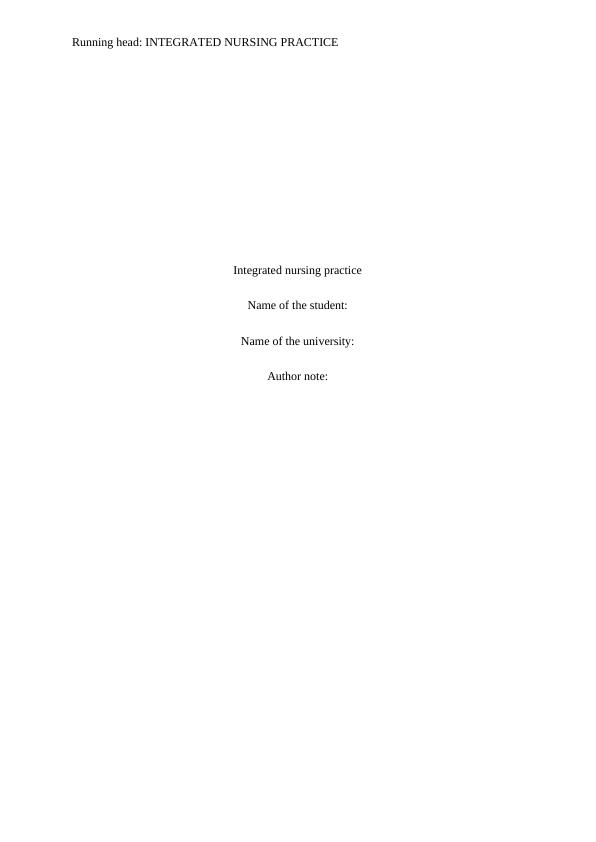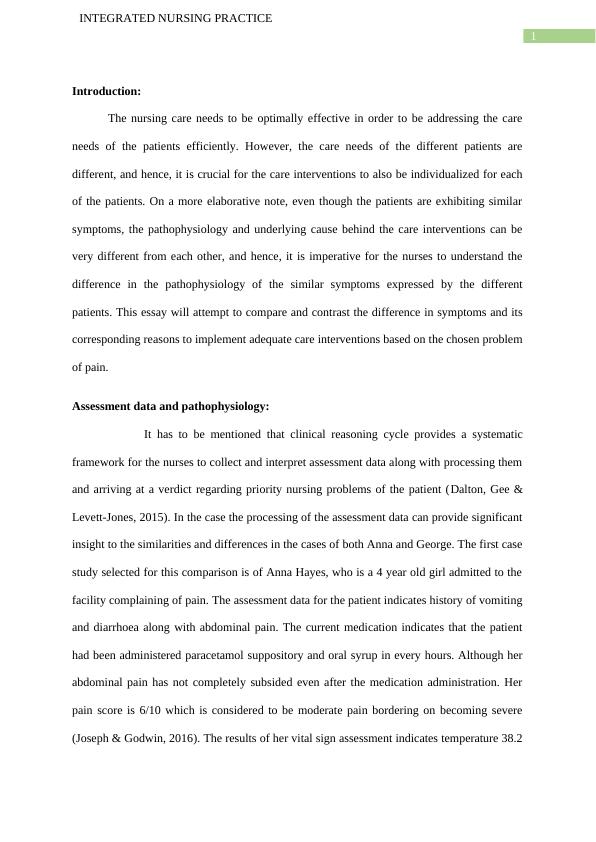Integrated Nursing Practice: Pain Management Comparison and Intervention
Added on 2023-06-05
10 Pages2823 Words300 Views
Running head: INTEGRATED NURSING PRACTICE
Integrated nursing practice
Name of the student:
Name of the university:
Author note:
Integrated nursing practice
Name of the student:
Name of the university:
Author note:

1
INTEGRATED NURSING PRACTICE
Introduction:
The nursing care needs to be optimally effective in order to be addressing the care
needs of the patients efficiently. However, the care needs of the different patients are
different, and hence, it is crucial for the care interventions to also be individualized for each
of the patients. On a more elaborative note, even though the patients are exhibiting similar
symptoms, the pathophysiology and underlying cause behind the care interventions can be
very different from each other, and hence, it is imperative for the nurses to understand the
difference in the pathophysiology of the similar symptoms expressed by the different
patients. This essay will attempt to compare and contrast the difference in symptoms and its
corresponding reasons to implement adequate care interventions based on the chosen problem
of pain.
Assessment data and pathophysiology:
It has to be mentioned that clinical reasoning cycle provides a systematic
framework for the nurses to collect and interpret assessment data along with processing them
and arriving at a verdict regarding priority nursing problems of the patient (Dalton, Gee &
Levett-Jones, 2015). In the case the processing of the assessment data can provide significant
insight to the similarities and differences in the cases of both Anna and George. The first case
study selected for this comparison is of Anna Hayes, who is a 4 year old girl admitted to the
facility complaining of pain. The assessment data for the patient indicates history of vomiting
and diarrhoea along with abdominal pain. The current medication indicates that the patient
had been administered paracetamol suppository and oral syrup in every hours. Although her
abdominal pain has not completely subsided even after the medication administration. Her
pain score is 6/10 which is considered to be moderate pain bordering on becoming severe
(Joseph & Godwin, 2016). The results of her vital sign assessment indicates temperature 38.2
INTEGRATED NURSING PRACTICE
Introduction:
The nursing care needs to be optimally effective in order to be addressing the care
needs of the patients efficiently. However, the care needs of the different patients are
different, and hence, it is crucial for the care interventions to also be individualized for each
of the patients. On a more elaborative note, even though the patients are exhibiting similar
symptoms, the pathophysiology and underlying cause behind the care interventions can be
very different from each other, and hence, it is imperative for the nurses to understand the
difference in the pathophysiology of the similar symptoms expressed by the different
patients. This essay will attempt to compare and contrast the difference in symptoms and its
corresponding reasons to implement adequate care interventions based on the chosen problem
of pain.
Assessment data and pathophysiology:
It has to be mentioned that clinical reasoning cycle provides a systematic
framework for the nurses to collect and interpret assessment data along with processing them
and arriving at a verdict regarding priority nursing problems of the patient (Dalton, Gee &
Levett-Jones, 2015). In the case the processing of the assessment data can provide significant
insight to the similarities and differences in the cases of both Anna and George. The first case
study selected for this comparison is of Anna Hayes, who is a 4 year old girl admitted to the
facility complaining of pain. The assessment data for the patient indicates history of vomiting
and diarrhoea along with abdominal pain. The current medication indicates that the patient
had been administered paracetamol suppository and oral syrup in every hours. Although her
abdominal pain has not completely subsided even after the medication administration. Her
pain score is 6/10 which is considered to be moderate pain bordering on becoming severe
(Joseph & Godwin, 2016). The results of her vital sign assessment indicates temperature 38.2

2
INTEGRATED NURSING PRACTICE
0 C, BP 88/50, HR 118, R 22, SpO2 98% on room air, Weight 16kg. The consciousness
assessment data reveals the fact that Anna is drowsy, yet rousable and starts to cry when she
is awaken, possibly due to the pain and discomfort that she is feeling due to her symptoms.
According to the signs and symptoms that Anna has been exhibiting it is clear that she had
been suffering from viral gastroenteritis. As mentioned by Corcoran, Van Well and Van Loo
(2014), viral gastroenteritis is associated with clinical manifestations including watery stools,
nausea and vomiting and moderate to severe abdominal cramps, all of which had been
experienced by Anna as well. Anna also had mild fever which can be the innate response of
her body to the intestinal infection. The hypotension at 88/52 BP that she had been suffering
from can be due to the extreme watery stools, vomiting and fever which also has disrupted
the electrolyte balance of the body leading to a drop in oxygen availability of the body. This
is also the factor contributing to high respiratory rate and high heart rate compensating for the
disrupted oxygen availability of the body.
On the other hand, the next patient in comparison is the George McAdams who had
been suffering from GORD or the gastro-oesophageal reflux disease. George also had very
similar symptoms of vomiting and diarrhoea. The priority problem for him has as well been
abdominal pain. However, his condition and the pathophysiology if the clinical
manifestations had been very different to that of Anna. He is a frail, 85 year old man who had
past medical history of GORD (Garg & Gurusamy, 2015). GORD is gastro-oesophageal
reflux disease which leads to various abdominal complications. His vitals include
Temperature 38.2 C, HR 108 (irregular), BP 105/60, RR 22, and SpO 2 99%. Although, the
patient in this case had been experiencing symptoms that suggests viral gastroenteritis, acid
reflux has been also reported to cause vomiting and diarrhoea and well. As mentioned by the
Kang et al. (2018), the acid reflux causes considerable damage to the intestinal muscles
which in turn loses some degree of its functionality which eventually leads to stool
INTEGRATED NURSING PRACTICE
0 C, BP 88/50, HR 118, R 22, SpO2 98% on room air, Weight 16kg. The consciousness
assessment data reveals the fact that Anna is drowsy, yet rousable and starts to cry when she
is awaken, possibly due to the pain and discomfort that she is feeling due to her symptoms.
According to the signs and symptoms that Anna has been exhibiting it is clear that she had
been suffering from viral gastroenteritis. As mentioned by Corcoran, Van Well and Van Loo
(2014), viral gastroenteritis is associated with clinical manifestations including watery stools,
nausea and vomiting and moderate to severe abdominal cramps, all of which had been
experienced by Anna as well. Anna also had mild fever which can be the innate response of
her body to the intestinal infection. The hypotension at 88/52 BP that she had been suffering
from can be due to the extreme watery stools, vomiting and fever which also has disrupted
the electrolyte balance of the body leading to a drop in oxygen availability of the body. This
is also the factor contributing to high respiratory rate and high heart rate compensating for the
disrupted oxygen availability of the body.
On the other hand, the next patient in comparison is the George McAdams who had
been suffering from GORD or the gastro-oesophageal reflux disease. George also had very
similar symptoms of vomiting and diarrhoea. The priority problem for him has as well been
abdominal pain. However, his condition and the pathophysiology if the clinical
manifestations had been very different to that of Anna. He is a frail, 85 year old man who had
past medical history of GORD (Garg & Gurusamy, 2015). GORD is gastro-oesophageal
reflux disease which leads to various abdominal complications. His vitals include
Temperature 38.2 C, HR 108 (irregular), BP 105/60, RR 22, and SpO 2 99%. Although, the
patient in this case had been experiencing symptoms that suggests viral gastroenteritis, acid
reflux has been also reported to cause vomiting and diarrhoea and well. As mentioned by the
Kang et al. (2018), the acid reflux causes considerable damage to the intestinal muscles
which in turn loses some degree of its functionality which eventually leads to stool

End of preview
Want to access all the pages? Upload your documents or become a member.
Related Documents
Nursing Assignment: Developmental Similarities and Differences in Clinical Conditionslg...
|10
|2446
|174
Nursing Considerations for Gastroenteritis in Reginald Bowenlg...
|6
|1325
|313
Nursing Assignmentlg...
|8
|2617
|414
Nursing Assignment on Gastroenteritis: Activities of Living and Nursing Care Planlg...
|14
|3701
|476
NRSG257 - Child, Adolescent and Family Nursing - Case studylg...
|7
|1940
|51
Assessing Differences and Similarities of Practices Related to Meeting Abdominal Pain Care Needs of Diverse Individualslg...
|11
|2585
|257